International Tourism Management: Nepal Case Study Report
VerifiedAdded on 2020/02/14
|12
|3190
|106
Report
AI Summary
This report provides an executive summary of international tourism management in Nepal, using Nepal as a case study to illustrate the roles of various stakeholders. The report identifies and analyzes the key stakeholders, including the government, tourists, local communities, and tourism organizations, and their respective roles and responsibilities in promoting and managing tourism. The government's role encompasses policy-making, investment in infrastructure, and human resource development. Tourists provide feedback and promote the country, while also being responsible for environmental protection and respecting local culture. The local community plays a vital role in promoting attractions and communicating information, while tourism organizations attract tourists and present Nepal's beauty. The report emphasizes the interdependencies between these stakeholders and their contributions to the development of Nepal's tourism industry, concluding with a discussion of how these stakeholders contribute to sustainable tourism practices. This report is a valuable resource for students studying tourism management, providing insights into the practical application of tourism principles in a real-world context.
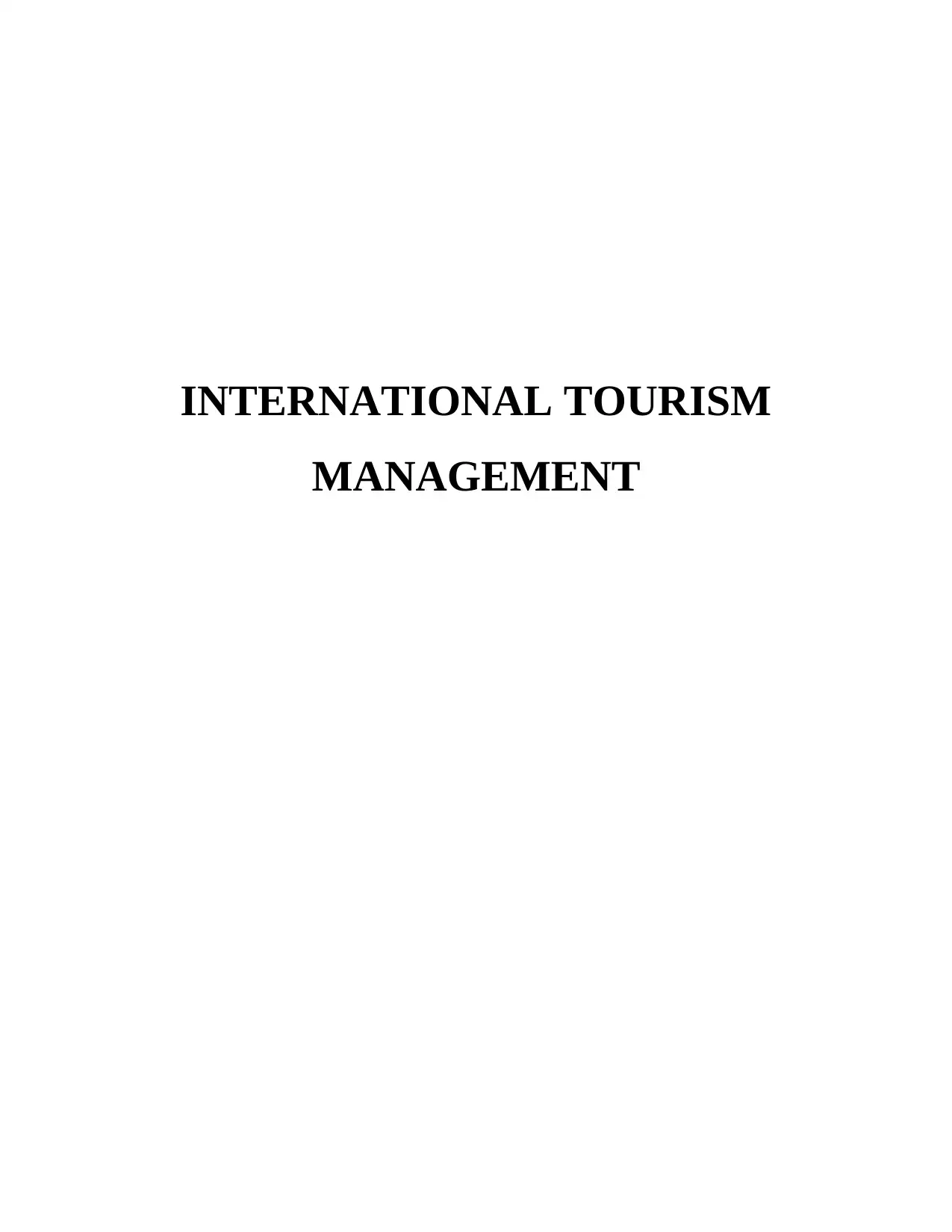
INTERNATIONAL TOURISM
MANAGEMENT
MANAGEMENT
Paraphrase This Document
Need a fresh take? Get an instant paraphrase of this document with our AI Paraphraser
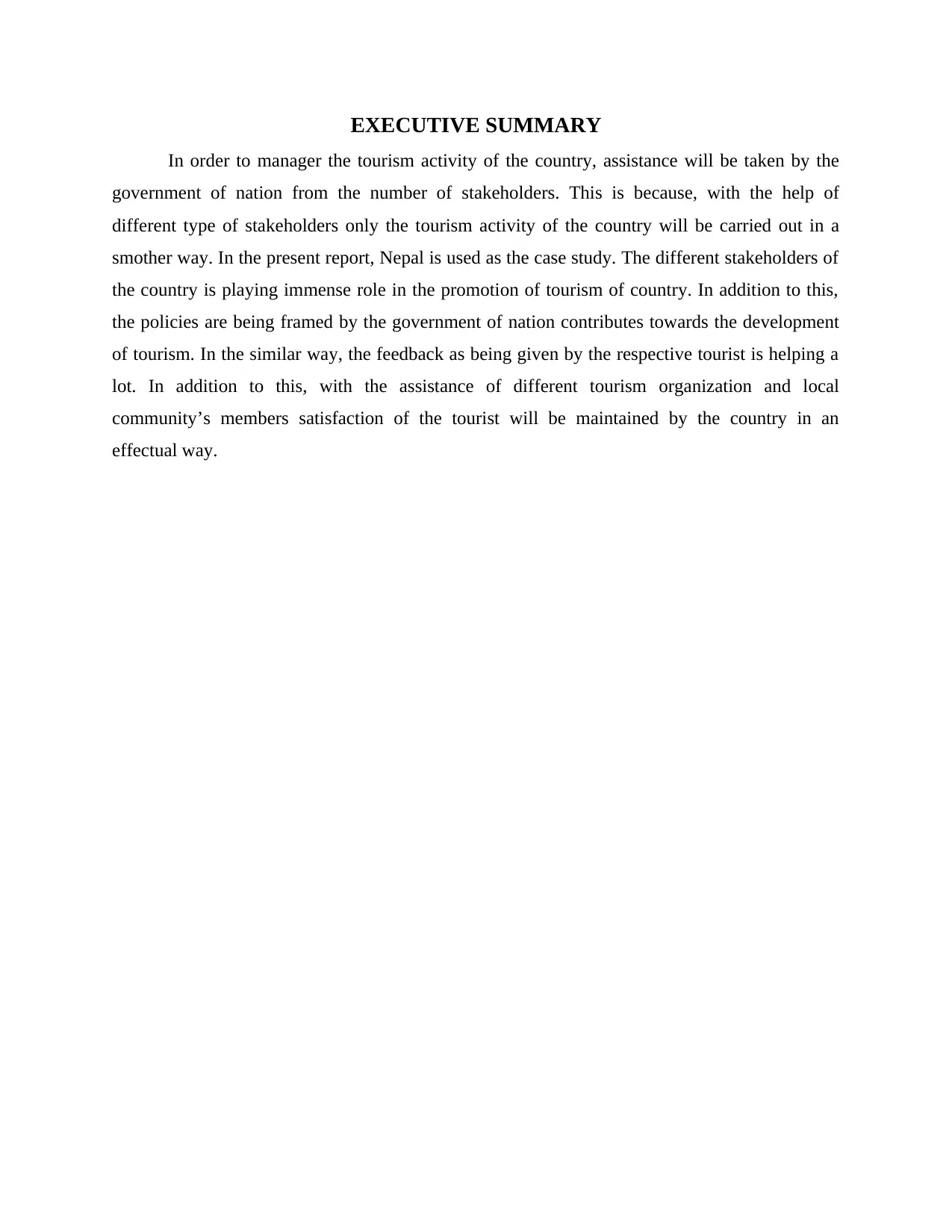
EXECUTIVE SUMMARY
In order to manager the tourism activity of the country, assistance will be taken by the
government of nation from the number of stakeholders. This is because, with the help of
different type of stakeholders only the tourism activity of the country will be carried out in a
smother way. In the present report, Nepal is used as the case study. The different stakeholders of
the country is playing immense role in the promotion of tourism of country. In addition to this,
the policies are being framed by the government of nation contributes towards the development
of tourism. In the similar way, the feedback as being given by the respective tourist is helping a
lot. In addition to this, with the assistance of different tourism organization and local
community’s members satisfaction of the tourist will be maintained by the country in an
effectual way.
In order to manager the tourism activity of the country, assistance will be taken by the
government of nation from the number of stakeholders. This is because, with the help of
different type of stakeholders only the tourism activity of the country will be carried out in a
smother way. In the present report, Nepal is used as the case study. The different stakeholders of
the country is playing immense role in the promotion of tourism of country. In addition to this,
the policies are being framed by the government of nation contributes towards the development
of tourism. In the similar way, the feedback as being given by the respective tourist is helping a
lot. In addition to this, with the assistance of different tourism organization and local
community’s members satisfaction of the tourist will be maintained by the country in an
effectual way.
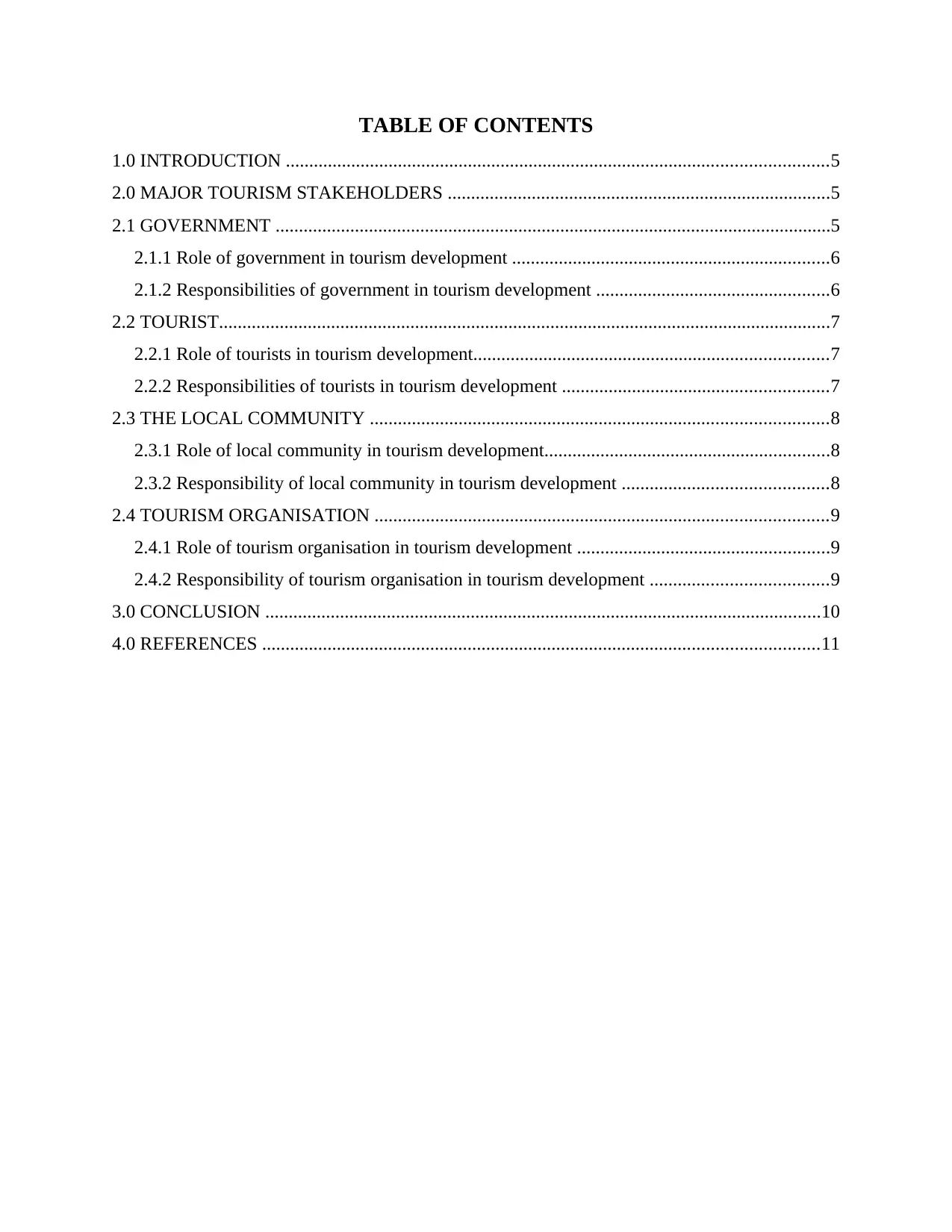
TABLE OF CONTENTS
1.0 INTRODUCTION ....................................................................................................................5
2.0 MAJOR TOURISM STAKEHOLDERS ..................................................................................5
2.1 GOVERNMENT .......................................................................................................................5
2.1.1 Role of government in tourism development ....................................................................6
2.1.2 Responsibilities of government in tourism development ..................................................6
2.2 TOURIST...................................................................................................................................7
2.2.1 Role of tourists in tourism development............................................................................7
2.2.2 Responsibilities of tourists in tourism development .........................................................7
2.3 THE LOCAL COMMUNITY ..................................................................................................8
2.3.1 Role of local community in tourism development.............................................................8
2.3.2 Responsibility of local community in tourism development ............................................8
2.4 TOURISM ORGANISATION .................................................................................................9
2.4.1 Role of tourism organisation in tourism development ......................................................9
2.4.2 Responsibility of tourism organisation in tourism development ......................................9
3.0 CONCLUSION .......................................................................................................................10
4.0 REFERENCES .......................................................................................................................11
1.0 INTRODUCTION ....................................................................................................................5
2.0 MAJOR TOURISM STAKEHOLDERS ..................................................................................5
2.1 GOVERNMENT .......................................................................................................................5
2.1.1 Role of government in tourism development ....................................................................6
2.1.2 Responsibilities of government in tourism development ..................................................6
2.2 TOURIST...................................................................................................................................7
2.2.1 Role of tourists in tourism development............................................................................7
2.2.2 Responsibilities of tourists in tourism development .........................................................7
2.3 THE LOCAL COMMUNITY ..................................................................................................8
2.3.1 Role of local community in tourism development.............................................................8
2.3.2 Responsibility of local community in tourism development ............................................8
2.4 TOURISM ORGANISATION .................................................................................................9
2.4.1 Role of tourism organisation in tourism development ......................................................9
2.4.2 Responsibility of tourism organisation in tourism development ......................................9
3.0 CONCLUSION .......................................................................................................................10
4.0 REFERENCES .......................................................................................................................11
⊘ This is a preview!⊘
Do you want full access?
Subscribe today to unlock all pages.

Trusted by 1+ million students worldwide

ILLUSTRATION INDEX
Illustration 1: Local community in Nepal........................................................................................8
Illustration 1: Local community in Nepal........................................................................................8
Paraphrase This Document
Need a fresh take? Get an instant paraphrase of this document with our AI Paraphraser
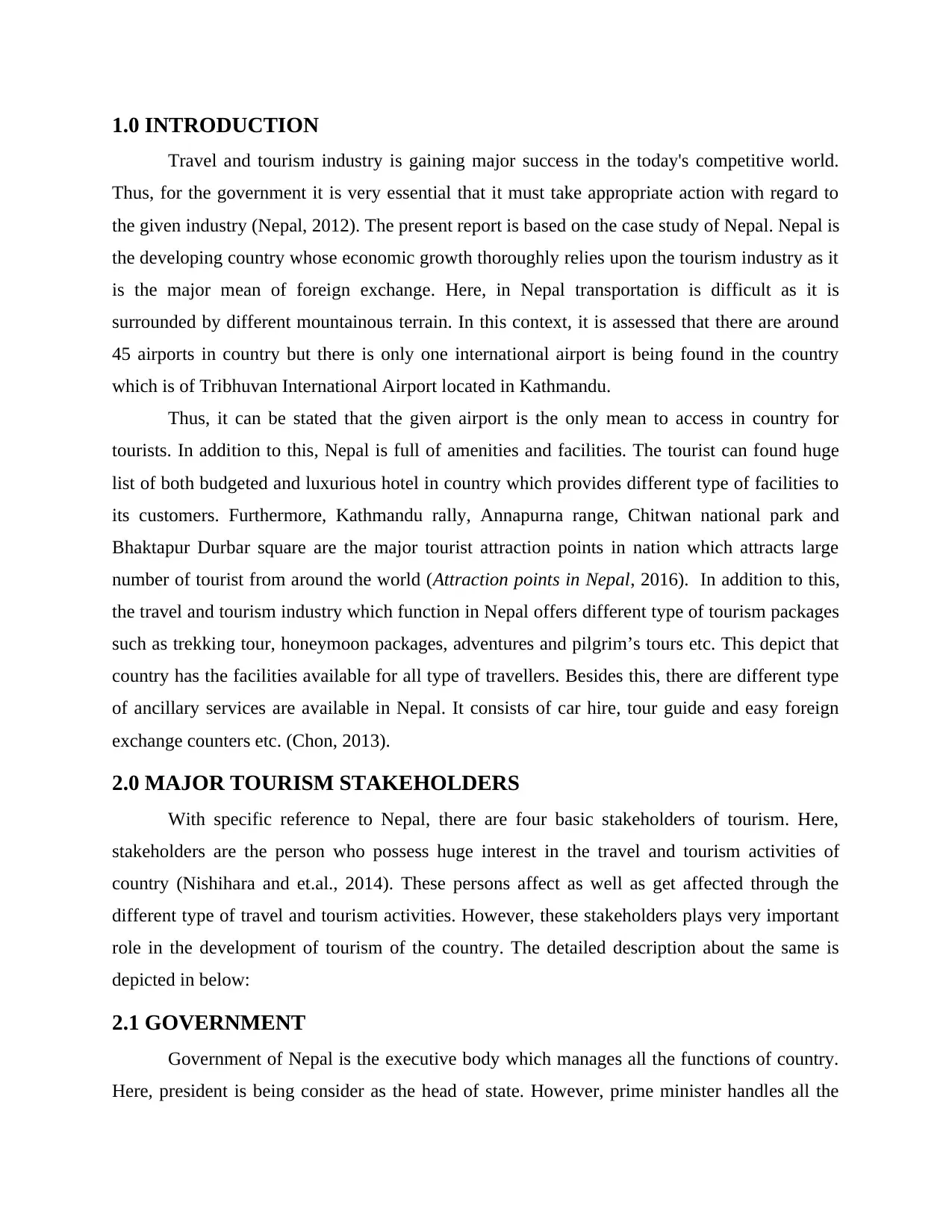
1.0 INTRODUCTION
Travel and tourism industry is gaining major success in the today's competitive world.
Thus, for the government it is very essential that it must take appropriate action with regard to
the given industry (Nepal, 2012). The present report is based on the case study of Nepal. Nepal is
the developing country whose economic growth thoroughly relies upon the tourism industry as it
is the major mean of foreign exchange. Here, in Nepal transportation is difficult as it is
surrounded by different mountainous terrain. In this context, it is assessed that there are around
45 airports in country but there is only one international airport is being found in the country
which is of Tribhuvan International Airport located in Kathmandu.
Thus, it can be stated that the given airport is the only mean to access in country for
tourists. In addition to this, Nepal is full of amenities and facilities. The tourist can found huge
list of both budgeted and luxurious hotel in country which provides different type of facilities to
its customers. Furthermore, Kathmandu rally, Annapurna range, Chitwan national park and
Bhaktapur Durbar square are the major tourist attraction points in nation which attracts large
number of tourist from around the world (Attraction points in Nepal, 2016). In addition to this,
the travel and tourism industry which function in Nepal offers different type of tourism packages
such as trekking tour, honeymoon packages, adventures and pilgrim’s tours etc. This depict that
country has the facilities available for all type of travellers. Besides this, there are different type
of ancillary services are available in Nepal. It consists of car hire, tour guide and easy foreign
exchange counters etc. (Chon, 2013).
2.0 MAJOR TOURISM STAKEHOLDERS
With specific reference to Nepal, there are four basic stakeholders of tourism. Here,
stakeholders are the person who possess huge interest in the travel and tourism activities of
country (Nishihara and et.al., 2014). These persons affect as well as get affected through the
different type of travel and tourism activities. However, these stakeholders plays very important
role in the development of tourism of the country. The detailed description about the same is
depicted in below:
2.1 GOVERNMENT
Government of Nepal is the executive body which manages all the functions of country.
Here, president is being consider as the head of state. However, prime minister handles all the
Travel and tourism industry is gaining major success in the today's competitive world.
Thus, for the government it is very essential that it must take appropriate action with regard to
the given industry (Nepal, 2012). The present report is based on the case study of Nepal. Nepal is
the developing country whose economic growth thoroughly relies upon the tourism industry as it
is the major mean of foreign exchange. Here, in Nepal transportation is difficult as it is
surrounded by different mountainous terrain. In this context, it is assessed that there are around
45 airports in country but there is only one international airport is being found in the country
which is of Tribhuvan International Airport located in Kathmandu.
Thus, it can be stated that the given airport is the only mean to access in country for
tourists. In addition to this, Nepal is full of amenities and facilities. The tourist can found huge
list of both budgeted and luxurious hotel in country which provides different type of facilities to
its customers. Furthermore, Kathmandu rally, Annapurna range, Chitwan national park and
Bhaktapur Durbar square are the major tourist attraction points in nation which attracts large
number of tourist from around the world (Attraction points in Nepal, 2016). In addition to this,
the travel and tourism industry which function in Nepal offers different type of tourism packages
such as trekking tour, honeymoon packages, adventures and pilgrim’s tours etc. This depict that
country has the facilities available for all type of travellers. Besides this, there are different type
of ancillary services are available in Nepal. It consists of car hire, tour guide and easy foreign
exchange counters etc. (Chon, 2013).
2.0 MAJOR TOURISM STAKEHOLDERS
With specific reference to Nepal, there are four basic stakeholders of tourism. Here,
stakeholders are the person who possess huge interest in the travel and tourism activities of
country (Nishihara and et.al., 2014). These persons affect as well as get affected through the
different type of travel and tourism activities. However, these stakeholders plays very important
role in the development of tourism of the country. The detailed description about the same is
depicted in below:
2.1 GOVERNMENT
Government of Nepal is the executive body which manages all the functions of country.
Here, president is being consider as the head of state. However, prime minister handles all the
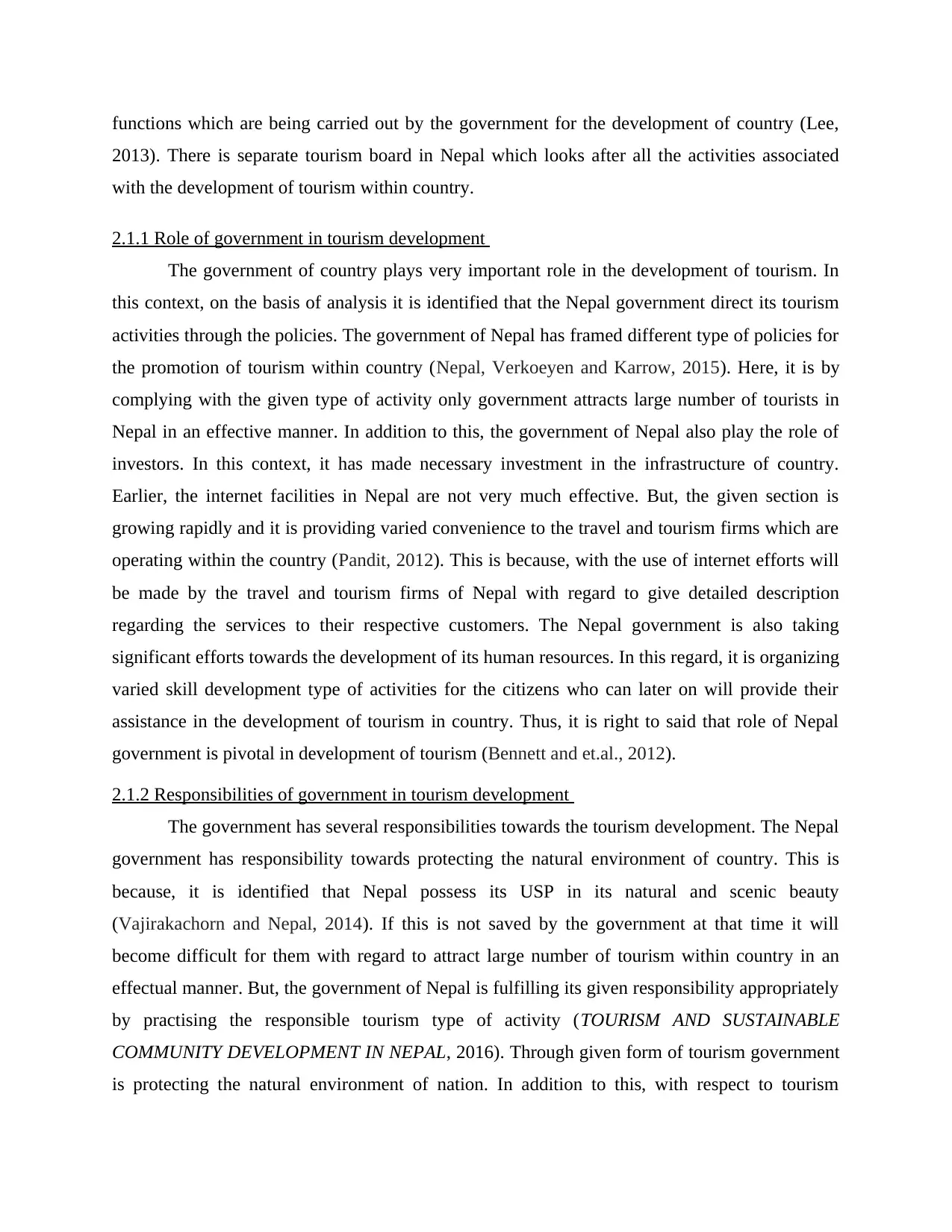
functions which are being carried out by the government for the development of country (Lee,
2013). There is separate tourism board in Nepal which looks after all the activities associated
with the development of tourism within country.
2.1.1 Role of government in tourism development
The government of country plays very important role in the development of tourism. In
this context, on the basis of analysis it is identified that the Nepal government direct its tourism
activities through the policies. The government of Nepal has framed different type of policies for
the promotion of tourism within country (Nepal, Verkoeyen and Karrow, 2015). Here, it is by
complying with the given type of activity only government attracts large number of tourists in
Nepal in an effective manner. In addition to this, the government of Nepal also play the role of
investors. In this context, it has made necessary investment in the infrastructure of country.
Earlier, the internet facilities in Nepal are not very much effective. But, the given section is
growing rapidly and it is providing varied convenience to the travel and tourism firms which are
operating within the country (Pandit, 2012). This is because, with the use of internet efforts will
be made by the travel and tourism firms of Nepal with regard to give detailed description
regarding the services to their respective customers. The Nepal government is also taking
significant efforts towards the development of its human resources. In this regard, it is organizing
varied skill development type of activities for the citizens who can later on will provide their
assistance in the development of tourism in country. Thus, it is right to said that role of Nepal
government is pivotal in development of tourism (Bennett and et.al., 2012).
2.1.2 Responsibilities of government in tourism development
The government has several responsibilities towards the tourism development. The Nepal
government has responsibility towards protecting the natural environment of country. This is
because, it is identified that Nepal possess its USP in its natural and scenic beauty
(Vajirakachorn and Nepal, 2014). If this is not saved by the government at that time it will
become difficult for them with regard to attract large number of tourism within country in an
effectual manner. But, the government of Nepal is fulfilling its given responsibility appropriately
by practising the responsible tourism type of activity (TOURISM AND SUSTAINABLE
COMMUNITY DEVELOPMENT IN NEPAL, 2016). Through given form of tourism government
is protecting the natural environment of nation. In addition to this, with respect to tourism
2013). There is separate tourism board in Nepal which looks after all the activities associated
with the development of tourism within country.
2.1.1 Role of government in tourism development
The government of country plays very important role in the development of tourism. In
this context, on the basis of analysis it is identified that the Nepal government direct its tourism
activities through the policies. The government of Nepal has framed different type of policies for
the promotion of tourism within country (Nepal, Verkoeyen and Karrow, 2015). Here, it is by
complying with the given type of activity only government attracts large number of tourists in
Nepal in an effective manner. In addition to this, the government of Nepal also play the role of
investors. In this context, it has made necessary investment in the infrastructure of country.
Earlier, the internet facilities in Nepal are not very much effective. But, the given section is
growing rapidly and it is providing varied convenience to the travel and tourism firms which are
operating within the country (Pandit, 2012). This is because, with the use of internet efforts will
be made by the travel and tourism firms of Nepal with regard to give detailed description
regarding the services to their respective customers. The Nepal government is also taking
significant efforts towards the development of its human resources. In this regard, it is organizing
varied skill development type of activities for the citizens who can later on will provide their
assistance in the development of tourism in country. Thus, it is right to said that role of Nepal
government is pivotal in development of tourism (Bennett and et.al., 2012).
2.1.2 Responsibilities of government in tourism development
The government has several responsibilities towards the tourism development. The Nepal
government has responsibility towards protecting the natural environment of country. This is
because, it is identified that Nepal possess its USP in its natural and scenic beauty
(Vajirakachorn and Nepal, 2014). If this is not saved by the government at that time it will
become difficult for them with regard to attract large number of tourism within country in an
effectual manner. But, the government of Nepal is fulfilling its given responsibility appropriately
by practising the responsible tourism type of activity (TOURISM AND SUSTAINABLE
COMMUNITY DEVELOPMENT IN NEPAL, 2016). Through given form of tourism government
is protecting the natural environment of nation. In addition to this, with respect to tourism
⊘ This is a preview!⊘
Do you want full access?
Subscribe today to unlock all pages.

Trusted by 1+ million students worldwide
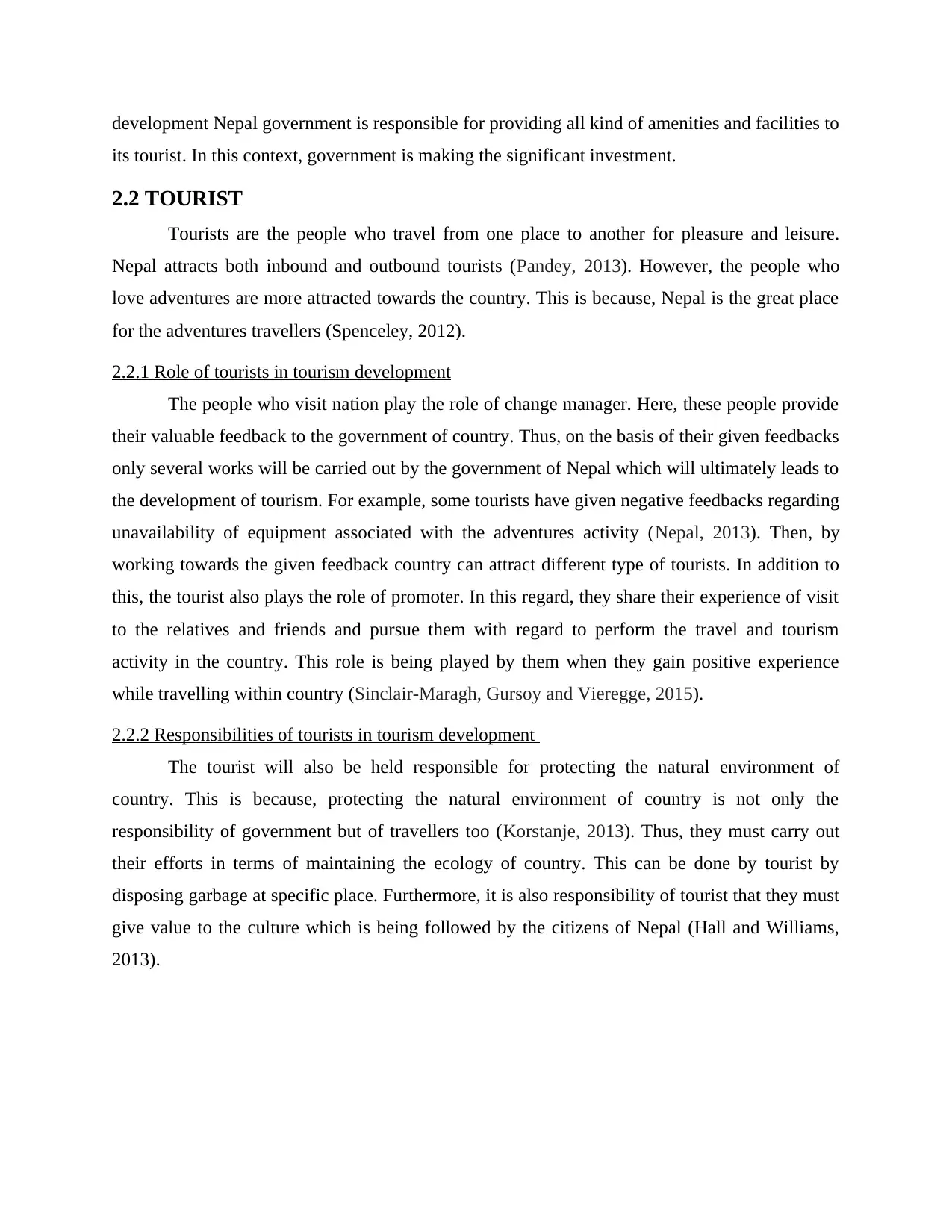
development Nepal government is responsible for providing all kind of amenities and facilities to
its tourist. In this context, government is making the significant investment.
2.2 TOURIST
Tourists are the people who travel from one place to another for pleasure and leisure.
Nepal attracts both inbound and outbound tourists (Pandey, 2013). However, the people who
love adventures are more attracted towards the country. This is because, Nepal is the great place
for the adventures travellers (Spenceley, 2012).
2.2.1 Role of tourists in tourism development
The people who visit nation play the role of change manager. Here, these people provide
their valuable feedback to the government of country. Thus, on the basis of their given feedbacks
only several works will be carried out by the government of Nepal which will ultimately leads to
the development of tourism. For example, some tourists have given negative feedbacks regarding
unavailability of equipment associated with the adventures activity (Nepal, 2013). Then, by
working towards the given feedback country can attract different type of tourists. In addition to
this, the tourist also plays the role of promoter. In this regard, they share their experience of visit
to the relatives and friends and pursue them with regard to perform the travel and tourism
activity in the country. This role is being played by them when they gain positive experience
while travelling within country (Sinclair-Maragh, Gursoy and Vieregge, 2015).
2.2.2 Responsibilities of tourists in tourism development
The tourist will also be held responsible for protecting the natural environment of
country. This is because, protecting the natural environment of country is not only the
responsibility of government but of travellers too (Korstanje, 2013). Thus, they must carry out
their efforts in terms of maintaining the ecology of country. This can be done by tourist by
disposing garbage at specific place. Furthermore, it is also responsibility of tourist that they must
give value to the culture which is being followed by the citizens of Nepal (Hall and Williams,
2013).
its tourist. In this context, government is making the significant investment.
2.2 TOURIST
Tourists are the people who travel from one place to another for pleasure and leisure.
Nepal attracts both inbound and outbound tourists (Pandey, 2013). However, the people who
love adventures are more attracted towards the country. This is because, Nepal is the great place
for the adventures travellers (Spenceley, 2012).
2.2.1 Role of tourists in tourism development
The people who visit nation play the role of change manager. Here, these people provide
their valuable feedback to the government of country. Thus, on the basis of their given feedbacks
only several works will be carried out by the government of Nepal which will ultimately leads to
the development of tourism. For example, some tourists have given negative feedbacks regarding
unavailability of equipment associated with the adventures activity (Nepal, 2013). Then, by
working towards the given feedback country can attract different type of tourists. In addition to
this, the tourist also plays the role of promoter. In this regard, they share their experience of visit
to the relatives and friends and pursue them with regard to perform the travel and tourism
activity in the country. This role is being played by them when they gain positive experience
while travelling within country (Sinclair-Maragh, Gursoy and Vieregge, 2015).
2.2.2 Responsibilities of tourists in tourism development
The tourist will also be held responsible for protecting the natural environment of
country. This is because, protecting the natural environment of country is not only the
responsibility of government but of travellers too (Korstanje, 2013). Thus, they must carry out
their efforts in terms of maintaining the ecology of country. This can be done by tourist by
disposing garbage at specific place. Furthermore, it is also responsibility of tourist that they must
give value to the culture which is being followed by the citizens of Nepal (Hall and Williams,
2013).
Paraphrase This Document
Need a fresh take? Get an instant paraphrase of this document with our AI Paraphraser
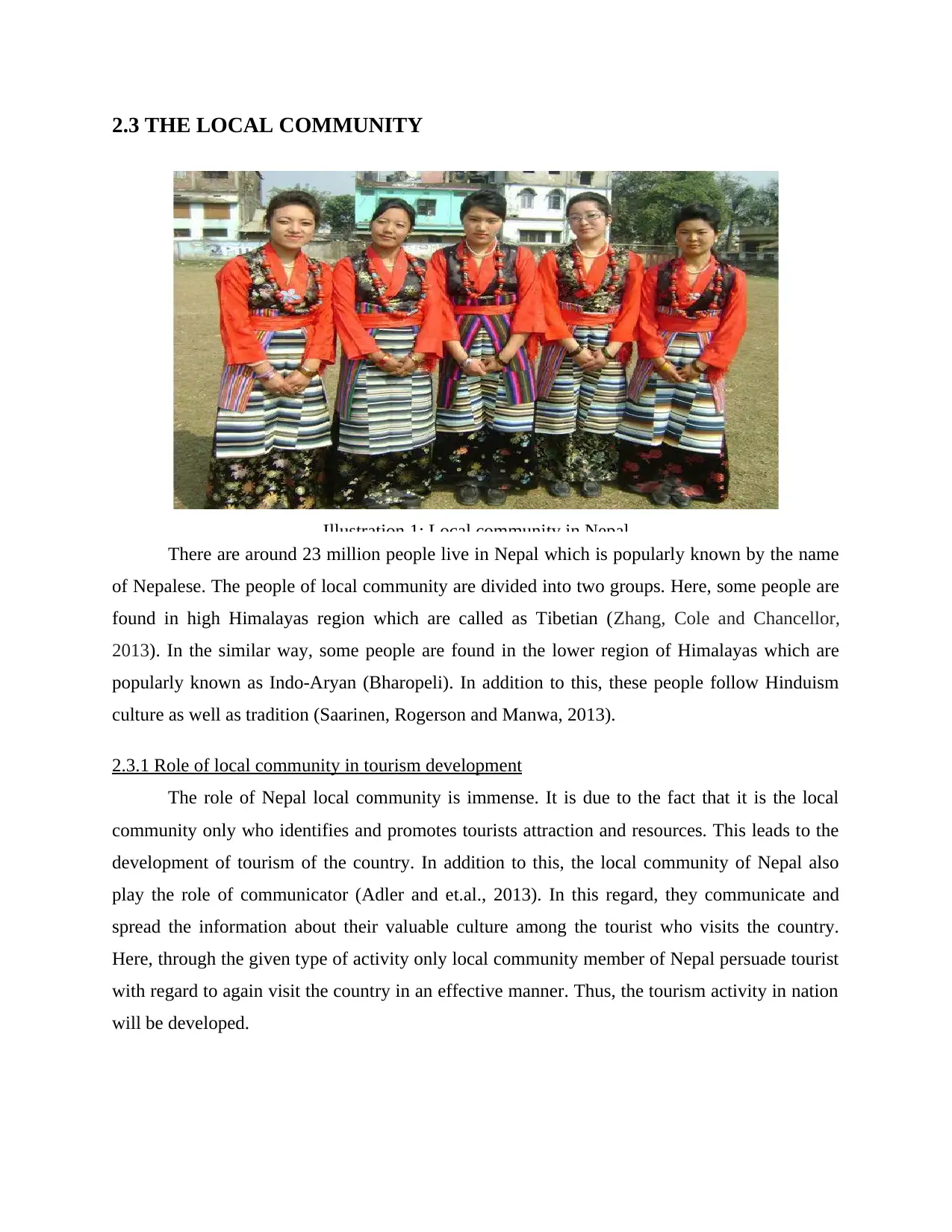
2.3 THE LOCAL COMMUNITY
There are around 23 million people live in Nepal which is popularly known by the name
of Nepalese. The people of local community are divided into two groups. Here, some people are
found in high Himalayas region which are called as Tibetian (Zhang, Cole and Chancellor,
2013). In the similar way, some people are found in the lower region of Himalayas which are
popularly known as Indo-Aryan (Bharopeli). In addition to this, these people follow Hinduism
culture as well as tradition (Saarinen, Rogerson and Manwa, 2013).
2.3.1 Role of local community in tourism development
The role of Nepal local community is immense. It is due to the fact that it is the local
community only who identifies and promotes tourists attraction and resources. This leads to the
development of tourism of the country. In addition to this, the local community of Nepal also
play the role of communicator (Adler and et.al., 2013). In this regard, they communicate and
spread the information about their valuable culture among the tourist who visits the country.
Here, through the given type of activity only local community member of Nepal persuade tourist
with regard to again visit the country in an effective manner. Thus, the tourism activity in nation
will be developed.
Illustration 1: Local community in Nepal
There are around 23 million people live in Nepal which is popularly known by the name
of Nepalese. The people of local community are divided into two groups. Here, some people are
found in high Himalayas region which are called as Tibetian (Zhang, Cole and Chancellor,
2013). In the similar way, some people are found in the lower region of Himalayas which are
popularly known as Indo-Aryan (Bharopeli). In addition to this, these people follow Hinduism
culture as well as tradition (Saarinen, Rogerson and Manwa, 2013).
2.3.1 Role of local community in tourism development
The role of Nepal local community is immense. It is due to the fact that it is the local
community only who identifies and promotes tourists attraction and resources. This leads to the
development of tourism of the country. In addition to this, the local community of Nepal also
play the role of communicator (Adler and et.al., 2013). In this regard, they communicate and
spread the information about their valuable culture among the tourist who visits the country.
Here, through the given type of activity only local community member of Nepal persuade tourist
with regard to again visit the country in an effective manner. Thus, the tourism activity in nation
will be developed.
Illustration 1: Local community in Nepal
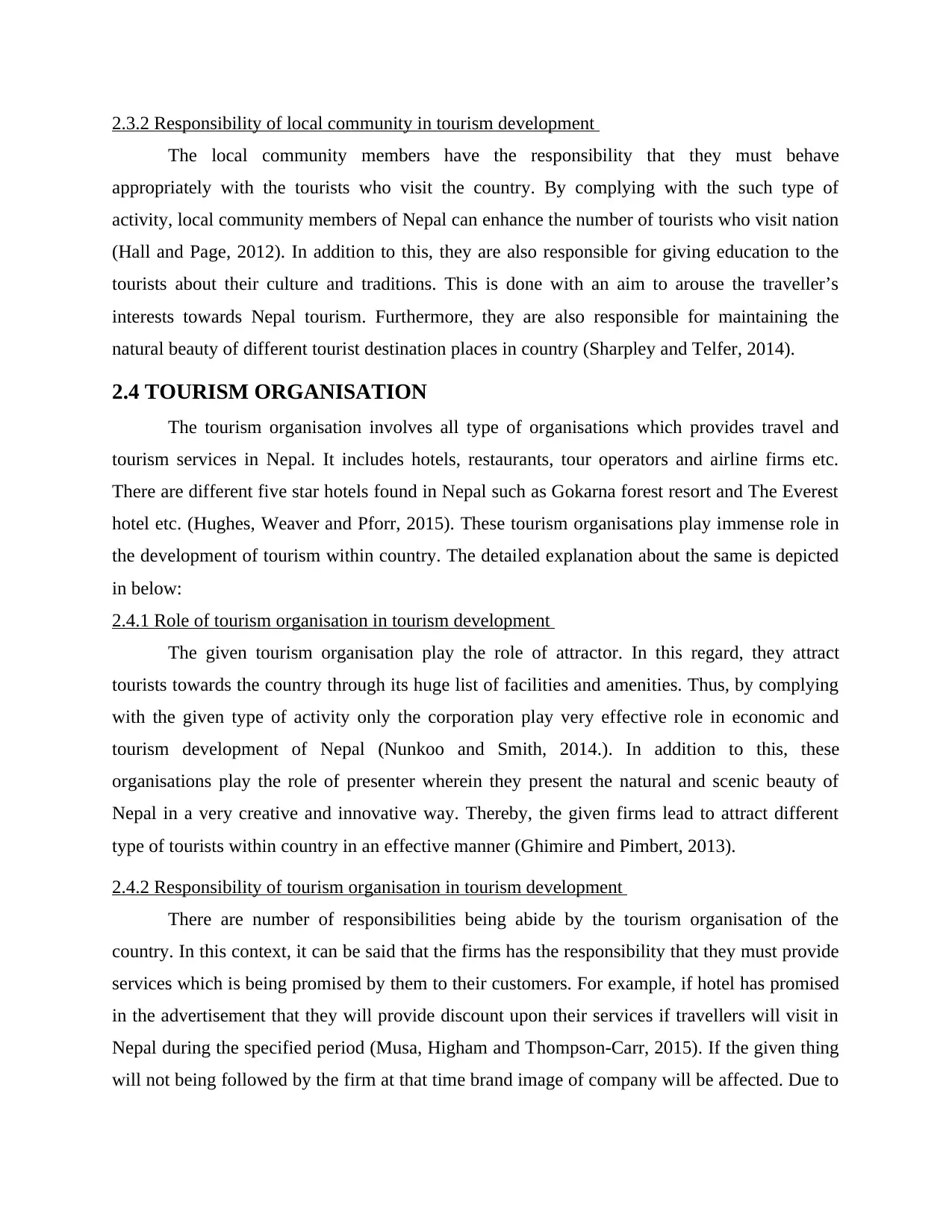
2.3.2 Responsibility of local community in tourism development
The local community members have the responsibility that they must behave
appropriately with the tourists who visit the country. By complying with the such type of
activity, local community members of Nepal can enhance the number of tourists who visit nation
(Hall and Page, 2012). In addition to this, they are also responsible for giving education to the
tourists about their culture and traditions. This is done with an aim to arouse the traveller’s
interests towards Nepal tourism. Furthermore, they are also responsible for maintaining the
natural beauty of different tourist destination places in country (Sharpley and Telfer, 2014).
2.4 TOURISM ORGANISATION
The tourism organisation involves all type of organisations which provides travel and
tourism services in Nepal. It includes hotels, restaurants, tour operators and airline firms etc.
There are different five star hotels found in Nepal such as Gokarna forest resort and The Everest
hotel etc. (Hughes, Weaver and Pforr, 2015). These tourism organisations play immense role in
the development of tourism within country. The detailed explanation about the same is depicted
in below:
2.4.1 Role of tourism organisation in tourism development
The given tourism organisation play the role of attractor. In this regard, they attract
tourists towards the country through its huge list of facilities and amenities. Thus, by complying
with the given type of activity only the corporation play very effective role in economic and
tourism development of Nepal (Nunkoo and Smith, 2014.). In addition to this, these
organisations play the role of presenter wherein they present the natural and scenic beauty of
Nepal in a very creative and innovative way. Thereby, the given firms lead to attract different
type of tourists within country in an effective manner (Ghimire and Pimbert, 2013).
2.4.2 Responsibility of tourism organisation in tourism development
There are number of responsibilities being abide by the tourism organisation of the
country. In this context, it can be said that the firms has the responsibility that they must provide
services which is being promised by them to their customers. For example, if hotel has promised
in the advertisement that they will provide discount upon their services if travellers will visit in
Nepal during the specified period (Musa, Higham and Thompson-Carr, 2015). If the given thing
will not being followed by the firm at that time brand image of company will be affected. Due to
The local community members have the responsibility that they must behave
appropriately with the tourists who visit the country. By complying with the such type of
activity, local community members of Nepal can enhance the number of tourists who visit nation
(Hall and Page, 2012). In addition to this, they are also responsible for giving education to the
tourists about their culture and traditions. This is done with an aim to arouse the traveller’s
interests towards Nepal tourism. Furthermore, they are also responsible for maintaining the
natural beauty of different tourist destination places in country (Sharpley and Telfer, 2014).
2.4 TOURISM ORGANISATION
The tourism organisation involves all type of organisations which provides travel and
tourism services in Nepal. It includes hotels, restaurants, tour operators and airline firms etc.
There are different five star hotels found in Nepal such as Gokarna forest resort and The Everest
hotel etc. (Hughes, Weaver and Pforr, 2015). These tourism organisations play immense role in
the development of tourism within country. The detailed explanation about the same is depicted
in below:
2.4.1 Role of tourism organisation in tourism development
The given tourism organisation play the role of attractor. In this regard, they attract
tourists towards the country through its huge list of facilities and amenities. Thus, by complying
with the given type of activity only the corporation play very effective role in economic and
tourism development of Nepal (Nunkoo and Smith, 2014.). In addition to this, these
organisations play the role of presenter wherein they present the natural and scenic beauty of
Nepal in a very creative and innovative way. Thereby, the given firms lead to attract different
type of tourists within country in an effective manner (Ghimire and Pimbert, 2013).
2.4.2 Responsibility of tourism organisation in tourism development
There are number of responsibilities being abide by the tourism organisation of the
country. In this context, it can be said that the firms has the responsibility that they must provide
services which is being promised by them to their customers. For example, if hotel has promised
in the advertisement that they will provide discount upon their services if travellers will visit in
Nepal during the specified period (Musa, Higham and Thompson-Carr, 2015). If the given thing
will not being followed by the firm at that time brand image of company will be affected. Due to
⊘ This is a preview!⊘
Do you want full access?
Subscribe today to unlock all pages.

Trusted by 1+ million students worldwide
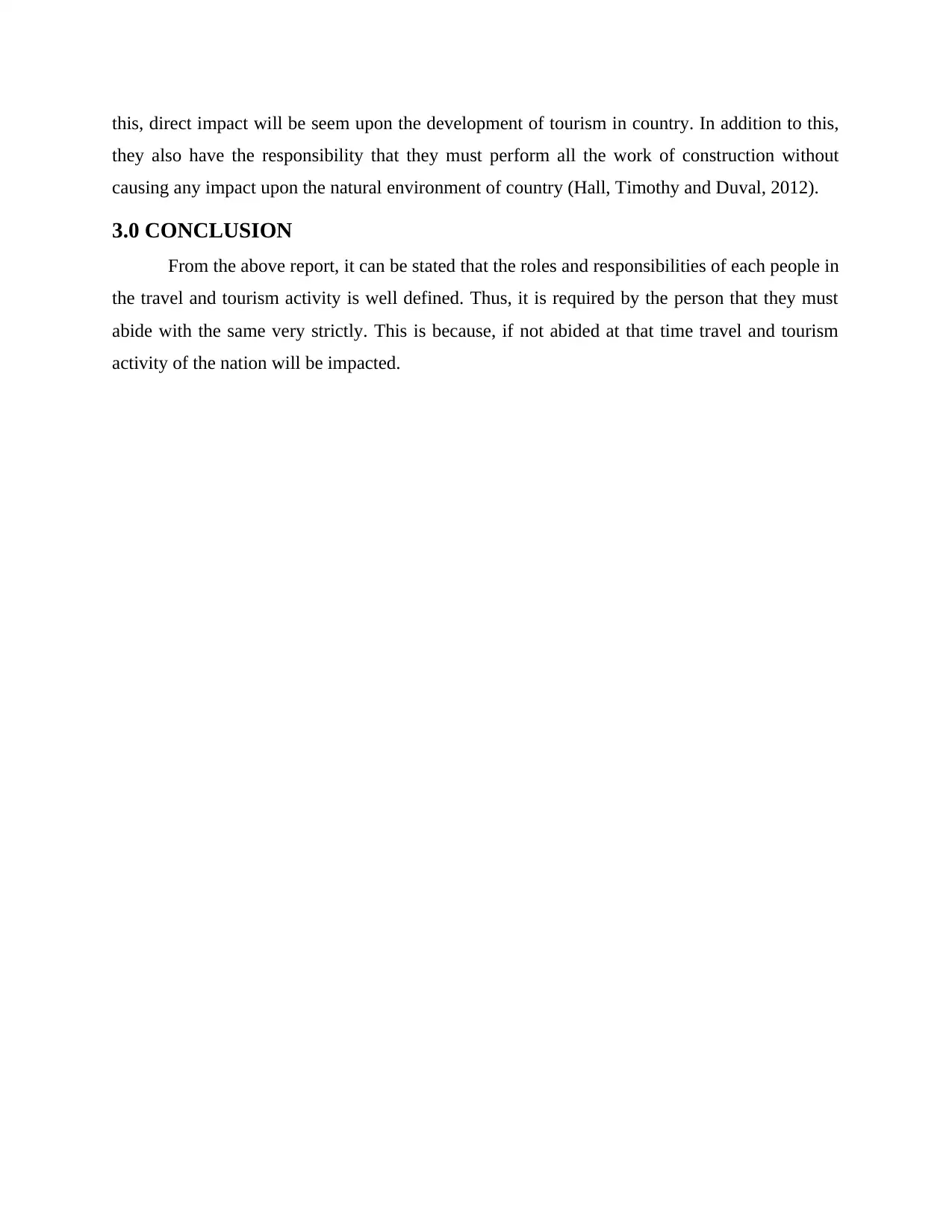
this, direct impact will be seem upon the development of tourism in country. In addition to this,
they also have the responsibility that they must perform all the work of construction without
causing any impact upon the natural environment of country (Hall, Timothy and Duval, 2012).
3.0 CONCLUSION
From the above report, it can be stated that the roles and responsibilities of each people in
the travel and tourism activity is well defined. Thus, it is required by the person that they must
abide with the same very strictly. This is because, if not abided at that time travel and tourism
activity of the nation will be impacted.
they also have the responsibility that they must perform all the work of construction without
causing any impact upon the natural environment of country (Hall, Timothy and Duval, 2012).
3.0 CONCLUSION
From the above report, it can be stated that the roles and responsibilities of each people in
the travel and tourism activity is well defined. Thus, it is required by the person that they must
abide with the same very strictly. This is because, if not abided at that time travel and tourism
activity of the nation will be impacted.
Paraphrase This Document
Need a fresh take? Get an instant paraphrase of this document with our AI Paraphraser
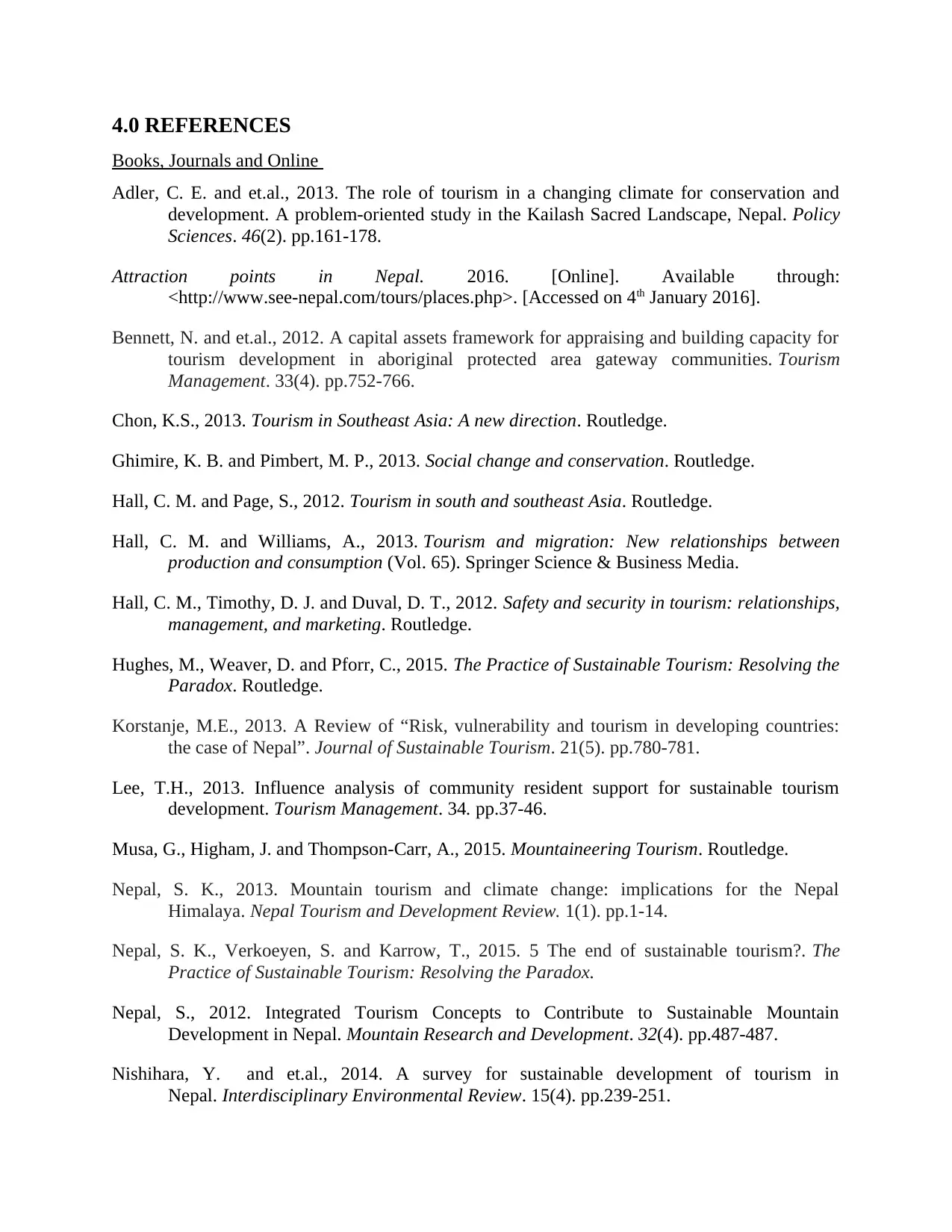
4.0 REFERENCES
Books, Journals and Online
Adler, C. E. and et.al., 2013. The role of tourism in a changing climate for conservation and
development. A problem-oriented study in the Kailash Sacred Landscape, Nepal. Policy
Sciences. 46(2). pp.161-178.
Attraction points in Nepal. 2016. [Online]. Available through:
<http://www.see-nepal.com/tours/places.php>. [Accessed on 4th January 2016].
Bennett, N. and et.al., 2012. A capital assets framework for appraising and building capacity for
tourism development in aboriginal protected area gateway communities. Tourism
Management. 33(4). pp.752-766.
Chon, K.S., 2013. Tourism in Southeast Asia: A new direction. Routledge.
Ghimire, K. B. and Pimbert, M. P., 2013. Social change and conservation. Routledge.
Hall, C. M. and Page, S., 2012. Tourism in south and southeast Asia. Routledge.
Hall, C. M. and Williams, A., 2013. Tourism and migration: New relationships between
production and consumption (Vol. 65). Springer Science & Business Media.
Hall, C. M., Timothy, D. J. and Duval, D. T., 2012. Safety and security in tourism: relationships,
management, and marketing. Routledge.
Hughes, M., Weaver, D. and Pforr, C., 2015. The Practice of Sustainable Tourism: Resolving the
Paradox. Routledge.
Korstanje, M.E., 2013. A Review of “Risk, vulnerability and tourism in developing countries:
the case of Nepal”. Journal of Sustainable Tourism. 21(5). pp.780-781.
Lee, T.H., 2013. Influence analysis of community resident support for sustainable tourism
development. Tourism Management. 34. pp.37-46.
Musa, G., Higham, J. and Thompson-Carr, A., 2015. Mountaineering Tourism. Routledge.
Nepal, S. K., 2013. Mountain tourism and climate change: implications for the Nepal
Himalaya. Nepal Tourism and Development Review. 1(1). pp.1-14.
Nepal, S. K., Verkoeyen, S. and Karrow, T., 2015. 5 The end of sustainable tourism?. The
Practice of Sustainable Tourism: Resolving the Paradox.
Nepal, S., 2012. Integrated Tourism Concepts to Contribute to Sustainable Mountain
Development in Nepal. Mountain Research and Development. 32(4). pp.487-487.
Nishihara, Y. and et.al., 2014. A survey for sustainable development of tourism in
Nepal. Interdisciplinary Environmental Review. 15(4). pp.239-251.
Books, Journals and Online
Adler, C. E. and et.al., 2013. The role of tourism in a changing climate for conservation and
development. A problem-oriented study in the Kailash Sacred Landscape, Nepal. Policy
Sciences. 46(2). pp.161-178.
Attraction points in Nepal. 2016. [Online]. Available through:
<http://www.see-nepal.com/tours/places.php>. [Accessed on 4th January 2016].
Bennett, N. and et.al., 2012. A capital assets framework for appraising and building capacity for
tourism development in aboriginal protected area gateway communities. Tourism
Management. 33(4). pp.752-766.
Chon, K.S., 2013. Tourism in Southeast Asia: A new direction. Routledge.
Ghimire, K. B. and Pimbert, M. P., 2013. Social change and conservation. Routledge.
Hall, C. M. and Page, S., 2012. Tourism in south and southeast Asia. Routledge.
Hall, C. M. and Williams, A., 2013. Tourism and migration: New relationships between
production and consumption (Vol. 65). Springer Science & Business Media.
Hall, C. M., Timothy, D. J. and Duval, D. T., 2012. Safety and security in tourism: relationships,
management, and marketing. Routledge.
Hughes, M., Weaver, D. and Pforr, C., 2015. The Practice of Sustainable Tourism: Resolving the
Paradox. Routledge.
Korstanje, M.E., 2013. A Review of “Risk, vulnerability and tourism in developing countries:
the case of Nepal”. Journal of Sustainable Tourism. 21(5). pp.780-781.
Lee, T.H., 2013. Influence analysis of community resident support for sustainable tourism
development. Tourism Management. 34. pp.37-46.
Musa, G., Higham, J. and Thompson-Carr, A., 2015. Mountaineering Tourism. Routledge.
Nepal, S. K., 2013. Mountain tourism and climate change: implications for the Nepal
Himalaya. Nepal Tourism and Development Review. 1(1). pp.1-14.
Nepal, S. K., Verkoeyen, S. and Karrow, T., 2015. 5 The end of sustainable tourism?. The
Practice of Sustainable Tourism: Resolving the Paradox.
Nepal, S., 2012. Integrated Tourism Concepts to Contribute to Sustainable Mountain
Development in Nepal. Mountain Research and Development. 32(4). pp.487-487.
Nishihara, Y. and et.al., 2014. A survey for sustainable development of tourism in
Nepal. Interdisciplinary Environmental Review. 15(4). pp.239-251.
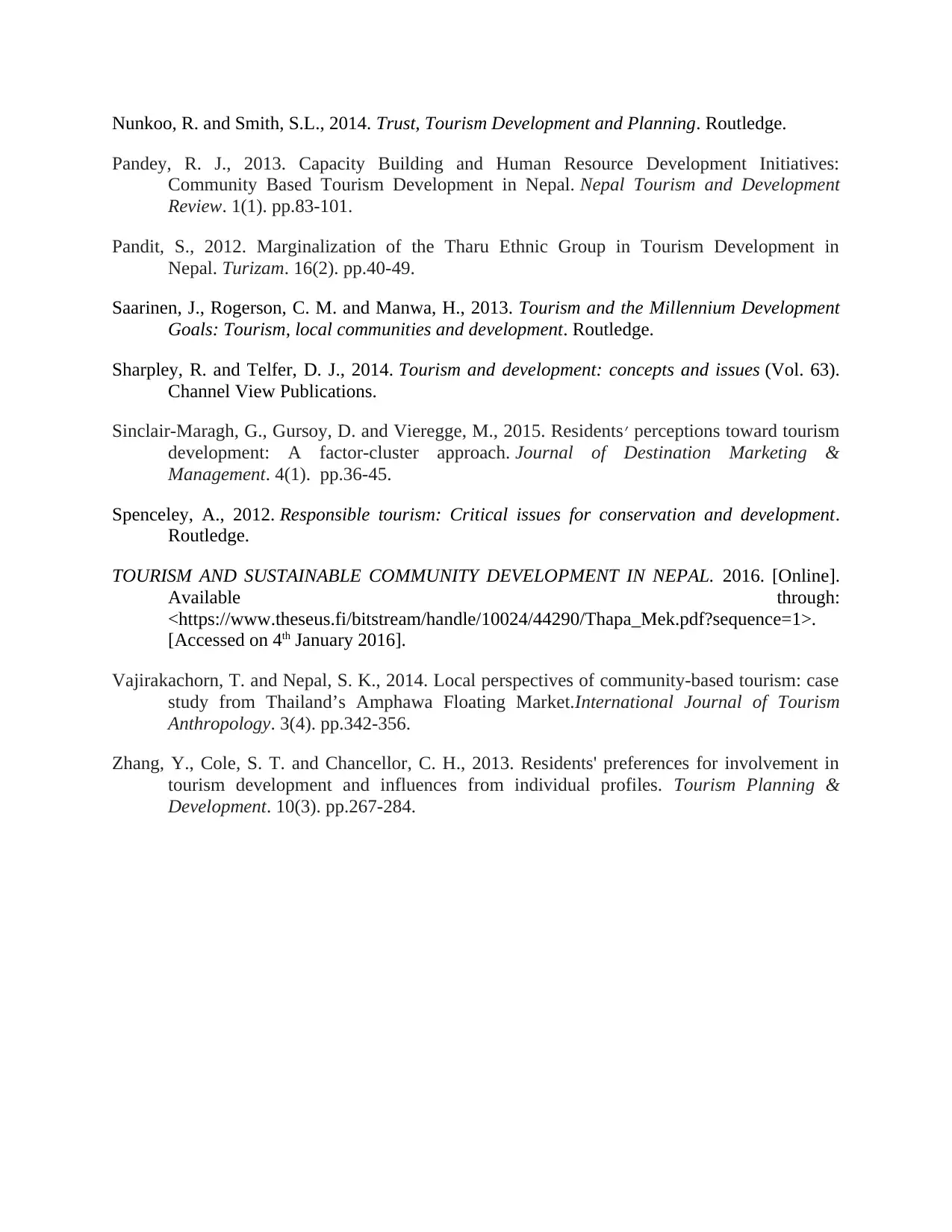
Nunkoo, R. and Smith, S.L., 2014. Trust, Tourism Development and Planning. Routledge.
Pandey, R. J., 2013. Capacity Building and Human Resource Development Initiatives:
Community Based Tourism Development in Nepal. Nepal Tourism and Development
Review. 1(1). pp.83-101.
Pandit, S., 2012. Marginalization of the Tharu Ethnic Group in Tourism Development in
Nepal. Turizam. 16(2). pp.40-49.
Saarinen, J., Rogerson, C. M. and Manwa, H., 2013. Tourism and the Millennium Development
Goals: Tourism, local communities and development. Routledge.
Sharpley, R. and Telfer, D. J., 2014. Tourism and development: concepts and issues (Vol. 63).
Channel View Publications.
Sinclair-Maragh, G., Gursoy, D. and Vieregge, M., 2015. Residents׳ perceptions toward tourism
development: A factor-cluster approach. Journal of Destination Marketing &
Management. 4(1). pp.36-45.
Spenceley, A., 2012. Responsible tourism: Critical issues for conservation and development.
Routledge.
TOURISM AND SUSTAINABLE COMMUNITY DEVELOPMENT IN NEPAL. 2016. [Online].
Available through:
<https://www.theseus.fi/bitstream/handle/10024/44290/Thapa_Mek.pdf?sequence=1>.
[Accessed on 4th January 2016].
Vajirakachorn, T. and Nepal, S. K., 2014. Local perspectives of community-based tourism: case
study from Thailand’s Amphawa Floating Market.International Journal of Tourism
Anthropology. 3(4). pp.342-356.
Zhang, Y., Cole, S. T. and Chancellor, C. H., 2013. Residents' preferences for involvement in
tourism development and influences from individual profiles. Tourism Planning &
Development. 10(3). pp.267-284.
Pandey, R. J., 2013. Capacity Building and Human Resource Development Initiatives:
Community Based Tourism Development in Nepal. Nepal Tourism and Development
Review. 1(1). pp.83-101.
Pandit, S., 2012. Marginalization of the Tharu Ethnic Group in Tourism Development in
Nepal. Turizam. 16(2). pp.40-49.
Saarinen, J., Rogerson, C. M. and Manwa, H., 2013. Tourism and the Millennium Development
Goals: Tourism, local communities and development. Routledge.
Sharpley, R. and Telfer, D. J., 2014. Tourism and development: concepts and issues (Vol. 63).
Channel View Publications.
Sinclair-Maragh, G., Gursoy, D. and Vieregge, M., 2015. Residents׳ perceptions toward tourism
development: A factor-cluster approach. Journal of Destination Marketing &
Management. 4(1). pp.36-45.
Spenceley, A., 2012. Responsible tourism: Critical issues for conservation and development.
Routledge.
TOURISM AND SUSTAINABLE COMMUNITY DEVELOPMENT IN NEPAL. 2016. [Online].
Available through:
<https://www.theseus.fi/bitstream/handle/10024/44290/Thapa_Mek.pdf?sequence=1>.
[Accessed on 4th January 2016].
Vajirakachorn, T. and Nepal, S. K., 2014. Local perspectives of community-based tourism: case
study from Thailand’s Amphawa Floating Market.International Journal of Tourism
Anthropology. 3(4). pp.342-356.
Zhang, Y., Cole, S. T. and Chancellor, C. H., 2013. Residents' preferences for involvement in
tourism development and influences from individual profiles. Tourism Planning &
Development. 10(3). pp.267-284.
⊘ This is a preview!⊘
Do you want full access?
Subscribe today to unlock all pages.

Trusted by 1+ million students worldwide
1 out of 12
Related Documents
Your All-in-One AI-Powered Toolkit for Academic Success.
+13062052269
info@desklib.com
Available 24*7 on WhatsApp / Email
![[object Object]](/_next/static/media/star-bottom.7253800d.svg)
Unlock your academic potential
Copyright © 2020–2025 A2Z Services. All Rights Reserved. Developed and managed by ZUCOL.





